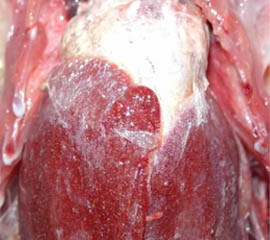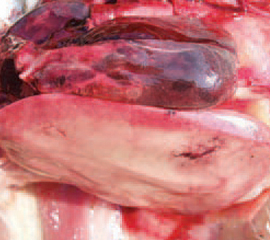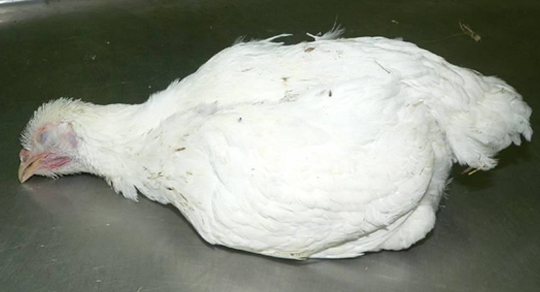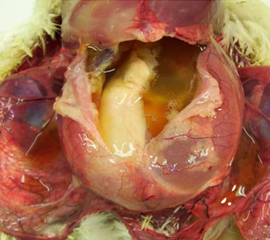 |
|
|
| METABOLIC DISEASES |
| Back |
Visceral gout/urolithiasis
- Gout/urolithiasis is a condition very commonly seen in older flocks and is related to kidney failure.
- On occasion, gout can be a very significant part of flock mortality, sometimes as high as 0.5 % per week, but is often an insignificant cause of low-grade mortality.
- Kidneys can be damaged by low phosphorus diets at any age, water deprivation at housing, high vitamin D3 in the ration, or excessive calcium before sexual maturity (15 to 16 weeks).
- The lesions of gout are associated with the accumulation of urates (uric acid is the primary nitrogenous excretory product of birds) on the surfaces of the internal organs (visceral gout) as well as within joint spaces and along synovial membranes (articular gout).
- The urates are gritty and white as opposed to inflammatory exudate from bacterial infections, such as colibacillosis, which are yellow and friable.
- Portions of kidney are atrophic or absent and contra-lateral portions are often swollen (compensatory hypertrophy).
- Birds can be treated with varying success by adding ammonium sulfate or ammonium chloride to the ration but these treatments may cause wet droppings and deterioration of shell quality.
- Gout can be prevented or minimized by providing the proper nutrition of calcium and phosphorus throughout growing (1 % calcium and 0.50 to 0.45% available phosphorus), starting layer levels of calcium feeding at the proper time (one week prior to first egg), and avoiding water deprivation at housing.
 |
| Visceral gout: Chalk-like urate deposits on pericardial sac and liver capsule
|
Fatty liver syndrome:
- Fatty liver is caused by an imbalance of energy (positive energy gain) and protein intake.
- Caged birds are particularly prone to fatty liver because of minimal exercise accompanied by high calorie intake.
- The liver is enlarged, pale orange, soft, friable and is easily fractured. Rupture of the fatty liver with hemorrhage into the abdominal cavity is a common cause of death.
- Treatment with choline chloride, vitamin K, biotin, and vitamin E in the feed for two weeks has been used to control mortality with varying results- these treatments are generally ineffective and not recommended.
- Fatty liver is positive-calorie problem and is prevented by use of an adequate diet with proper energy and protein levels- reduce these levels in the feed to prevent obesity in birds.
 |
| Fatty liver syndrome: Pale, fatty and friable liver is susceptible to rupture and hemorrhage.
|
Ascites Syndrome and Right Ventricular Failure of Broiler Chickens
Ascites: accumulation of clear (serous transudate) fluid in the abdomen.
Clinical signs:
Sudden death of previously healthy birds, usually at 3-5 weeks of age, in a flock with good rate of weight gain. Live birds are smaller than normal, reluctant to move, have respiratory distress and a distended abdomen. Combs and wattles are cyanotic (pale to bluish).
Gross lesions:
- Cyanotic combs and wattles.
- The abdomen is distended by abundant clear, yellow fluid and fibrin.
- Fibrin clots often surround the liver, which is small.
- Lungs are dark red and wet (edema).
- The pericardial sac can be filled with clear fluid (hydropericardium).
- The right ventricle is dilated with thin, flaccid wall and there can be degeneration of the right atrio-ventricular valves as evidenced by firm, white nodules (endocardiosis).
- The right ventricle is predisposed to failure because of a septal valve that is composed entirely of cardiac muscle rather than fibrous connective tissue.
Predisposing factors:
- Broiler chickens that are bred for high feed efficiency with rapid rate of growth and muscle development.
- Broiler chickens have lower ratio of total lung volume : body weight compared to ancestor (Red Jungle Fowl) or white leghorn chicken.
- Continuous availability (ad libitum) of high energy and high quality feeds typical of grower ration.
Diagnosis:
Decrease energy level in feed to slow down growth rate. Try limiting feed during the grow-out or turning off house lights at night. The birds should be acclimated to dark-out periods at an early age to minimize panic. If mortality is >1-2% from ascites look for other complicating factors such as high sodium levels in feed or water, vitamin E or selenium deficiency, respiratory infection, furazolidone or coal tar toxicity. Maintain good air quality with adequate ventilation, especially during winter.
 |
| Four-week-old broiler chicken in respiratory distress (facial cyanosis, prostration with neck extended) in terminal stages of ascites syndrome
|
 |
| Ascites Syndrome: Broiler chicken with abundant clear fluid distending the abdomen
|
|
| Back |
|
|
Developed by :
|
Dr.Rahulpreet Singh
( M.V.Sc Scholar ) |
Dr. Pranav Kumar
(Assistant Professor)
|
Dr. Amandeep Singh
(M.V.Sc Scholar, IVRI ) |
|
|
|
|
|
|
Scroll
|
| Division of Veterinary and Animal Husbandry Extension Education Faculty of Veterinary Sciences and Animal Husbandry, R.S. Pura, SKUAST Jammu |
|




